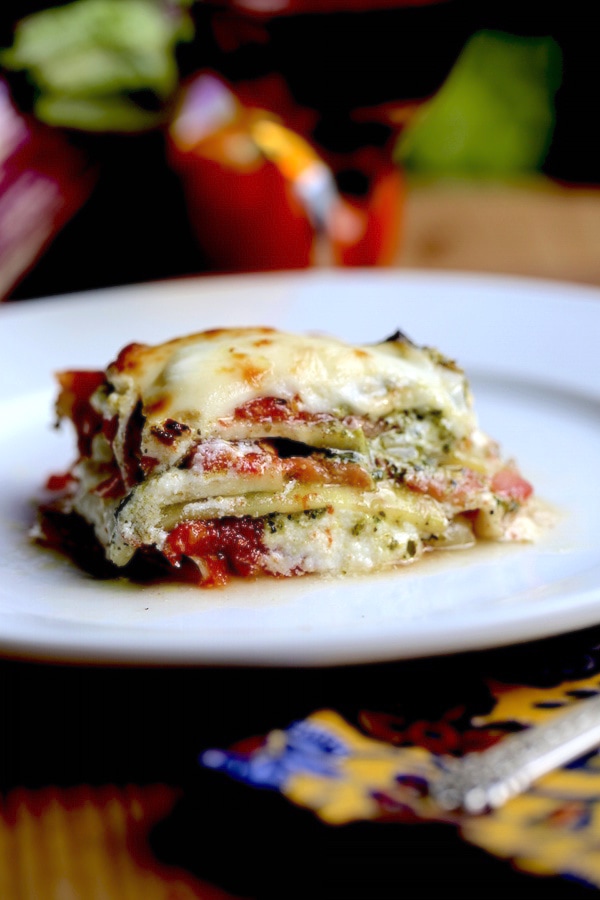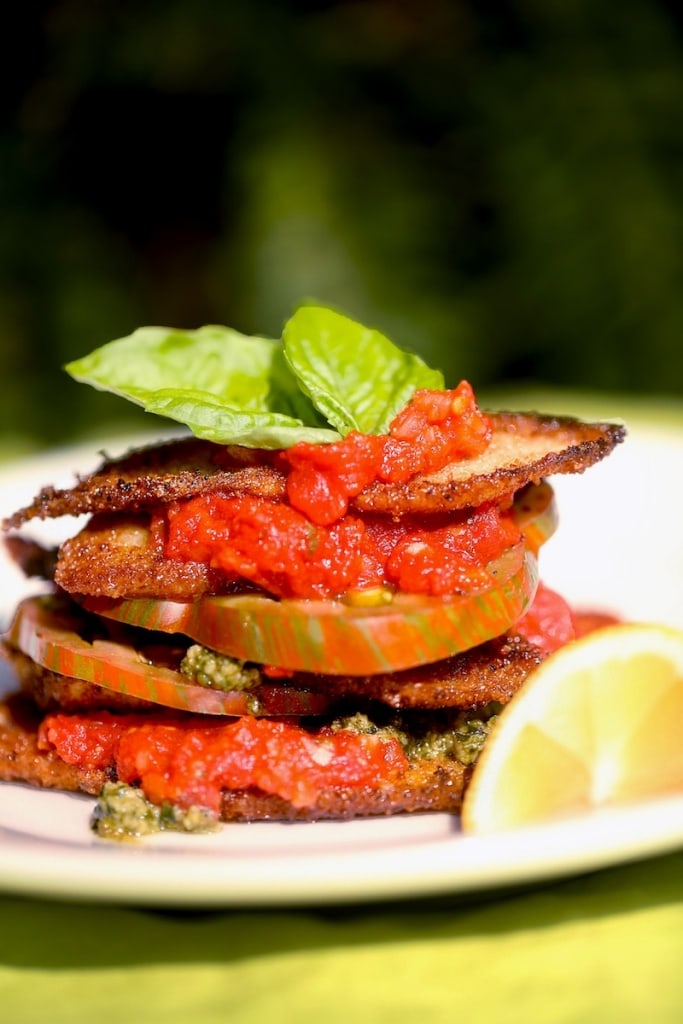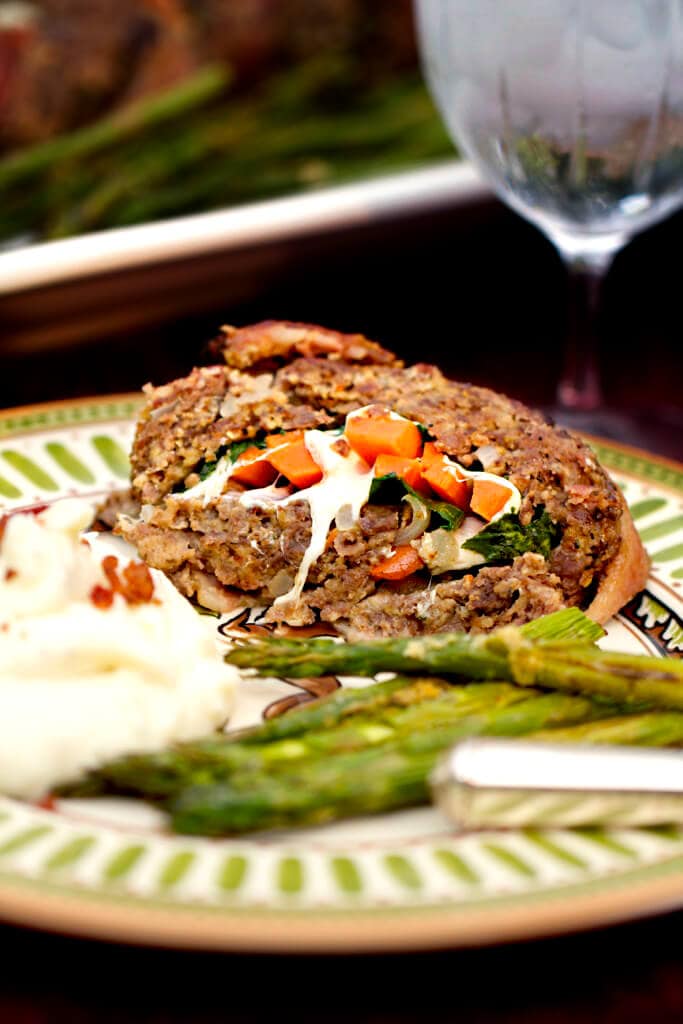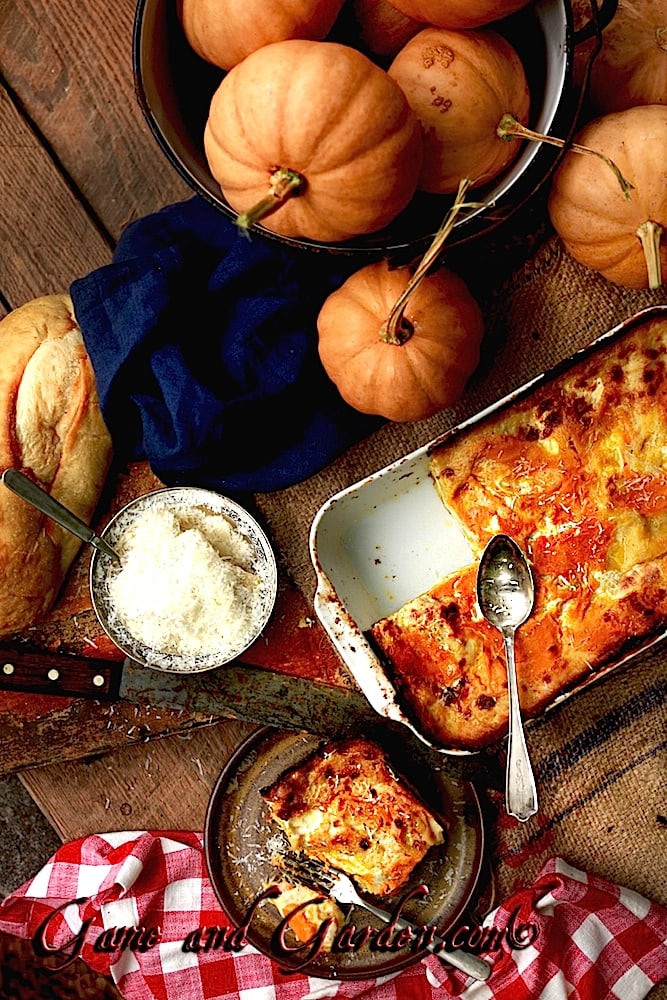Basil Pesto with Garden Fresh Basil
Are you tired of the same old recipes? Looking to add a burst of flavor to your meals? Look no further than basil pesto! From pasta to sandwiches to veggie lasagna, pesto is incredibly versatile. I always keep some on hand. It has rescued me from more than a few short-notice predicaments.

Basil pesto is a classic Italian condiment that packs a punch of flavor. But its uses go far beyond just being a pasta sauce. From appetizers to main courses and even breakfast, pesto lets you whip up gourmet masterpieces in minutes. Those friends who show up on short notice for lunch will think you labored in the kitchen for hours!
This versatile and vibrant sauce is a game-changer in the kitchen, elevating any dish from ordinary to extraordinary. Even better, it’s super simple to make.
Essential Ingredients for a Perfect Basil Pesto
To create a perfect basil pesto, you need to start with the right ingredients. Here’s a breakdown of the essentials:
Fresh Basil Leaves (or Other Herbs or Greens)
Look for vibrant green leaves that are free from any signs of wilting or yellowing. The fresher the basil, the better the flavor of your pesto. For that matter, you can also make a fabulous arugula pesto if you don’t have basil on hand. Cilantro or parsley are good as well. You can even use spinach or kale greens, though note that kale has a strong flavor.
Fresh Garlic
Use fresh garlic cloves for an intense and aromatic taste. Adjust the amount of garlic based on your preference, but be careful not to overpower the other flavors.
Pine Nuts (or Other Nuts)
These small, creamy nuts add a delicate nuttiness to the pesto. Toast them lightly before adding to enhance their flavor. While pine nuts are the traditional choice for pesto, you can get adventurous and try using other nuts like walnuts, almonds, or cashews.
Can I make pesto without nuts? Absolutely! If you have nut allergies or simply prefer a nut-free version, you can omit the nuts. You could also use sunflower seeds or pumpkin seeds in their place.
Romano or Parmesan Cheese
Grate a high-quality hard cheese like Romano or Parmesan cheese for a sharp, salty taste. (I like Romano for this recipe.) The cheese should be aged, as this will ensure a more robust flavor.
Extra Virgin Olive Oil
Use a good quality extra virgin olive oil to bind the ingredients together and add richness to the pesto.
Salt and Pepper
Season your pesto with Kosher salt and freshly ground black pepper to enhance the flavors.
History and Origin of Basil Pesto
Basil pesto has a long and rich history that traces all the way back to ancient Rome. The word “pesto” itself comes from the Italian word pestare, which means “to pound or crush.” This refers to the traditional method of making pesto by grinding the ingredients together using a mortar and pestle.
A food processor or blender makes pesto a lot quicker these days — a bonus in my crazy-busy life — but you can certainly go “old school” if you want!

The origins of basil pesto can be found in the Liguria region of Italy, where the climate is ideal for growing basil. The combination of fresh basil, garlic, pine nuts, grated cheese, and olive oil creates a sauce that is both aromatic and full of flavor.
Health Benefits of Basil Pesto
Not only is basil pesto delicious, but it also offers several health benefits. Basil is rich in antioxidants, which help protect the body against free radicals and reduce inflammation. It is also a good source of vitamins A, K, and C, as well as minerals such as calcium and iron.
The garlic in pesto has antimicrobial properties and may help boost the immune system. Olive oil, a key ingredient in basil pesto, is known for its heart-healthy properties and is a good source of monounsaturated fats. So, when you enjoy basil pesto, you’re not just treating your taste buds, but also nourishing your body. How great is that?
Basil Pesto to the Rescue
Basil pesto has saved me more than once. For example, I’ve had out-of-town friends call to tell me they are stopping by the house on their way home from a beach trip, right during the dinner hour. Trust me, having basil pesto on hand is a lifesaver in instances like this.
I like to serve it over hot noodles, with eggplant parmesan or fried squash, or over eggs for an easy, beautiful breakfast. Basil is easy to grow — even indoors in a sunny window — making pesto that much easier to keep on hand.

Creative Uses of Basil Pesto in Pasta, Lasagna, and Pizza
When it comes to pasta dishes, basil pesto is a game-changer. Traditional pesto pasta is a classic, favorite pasta dish, but you can get creative and experiment with different types of pasta and ingredients. For a refreshing twist, try mixing basil pesto with cooked linguine, cherry tomatoes, and fresh mozzarella. Toss everything together and garnish with fresh basil leaves.
Another delicious option is to combine pesto with roasted vegetables, such as zucchini, bell peppers, and eggplant. Basil pesto makes my eggplant lasagna recipe truly scrumptious. You can also make the recipe with grilled zucchini.
Try pesto as a pizza sauce! The possibilities are endless, and each dish will be bursting with flavor.
Incorporating Pesto in Sandwiches and Wraps
If you’re tired of boring sandwiches, basil pesto can take them to a whole new level. Spread a generous amount of pesto on your bread or wrap, and layer it with your favorite ingredients. For a vegetarian option, combine pesto with grilled vegetables, feta cheese, and arugula. If you prefer meat, try adding grilled chicken or turkey or ground venison or beef, along with some sliced tomatoes and fresh basil leaves. The combination of the vibrant pesto and the other ingredients will create a sandwich or burger that is both satisfying and delicious.
A Tasty Marinade or Sauce for Meat and Fish
Basil pesto is not just for pasta and sandwiches; it also makes an excellent marinade or sauce for meat and fish. Marinating chicken or salmon in pesto before grilling or baking will infuse the dish with a burst of flavor. The oils in the pesto help to keep the meat or fish moist and tender. For a quick and easy dinner, brush some pesto on chicken breasts and bake them in the oven. Voilà! Pesto chicken, a flavorful and juicy main course that will impress your family and friends.
Basil Pesto in Salads and Appetizers
Basil pesto can be used to dress up salads and create flavorful appetizers. For a refreshing salad, drizzle pesto over mixed greens, cherry tomatoes, cucumber, and avocado. Top it off with some toasted pine nuts for added crunch.
If you’re hosting a party, serve pesto as a dip alongside a platter of fresh vegetables, breadsticks, and crackers. You can also use pesto as a spread on crostini and top it with sliced mozzarella and cherry tomatoes.
Tips for Preparing Pesto
Below are a few points to keep in mind if you choose to add basil pesto sauce to your kitchen arsenal.

- Go easy with the blending: Using a blender or food processor can save you time and effort. However, be careful not to overblend, as this can result in a dull-colored pesto.
- Blanch the basil: For an even brighter green pesto, you can blanch the basil leaves in boiling water for a few seconds before blending. This helps to preserve the vibrant green color.
- Add lemon zest: For a refreshing twist, add a teaspoon of lemon zest to your pesto. This optional addition brightens up the flavors with a citrusy note.
- To store pesto: This pesto recipe will keep in the refrigerator for up to 5 days covered with a layer of oil and in an airtight container. The oil will keep the pesto from browning. Some people also use lemon juice for this purpose.
- To freeze pesto: Line an ice cube tray with plastic wrap and fill each pocket with pesto. Freeze, remove from tray, and store in freezer bag for up to three months. This will give you handy individual portions to thaw as needed.
- Note: If you are going to freeze, omit the cheese and add it after the pesto has thawed. The thawed pesto will be a bit runny, but it will thicken once you add the cheese.
- Tip for growing basil: Nothing beats homemade pesto with garden-fresh basil. If you don’t have garden space, you can grow your basil in pots. Basil is an excellent insect repellent for us and our plants!
Stacy Lyn’s Basil Pesto Recipe
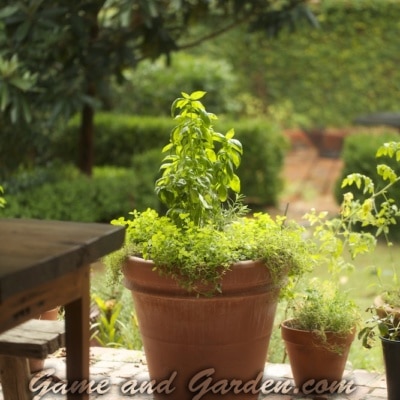
Basil Pesto
Ingredients
- ¼ cup pine nuts
- 3 cloves garlic
- 2½ cups basil leaves
- 1 cup Romano cheese
- ½ teaspoon Kosher salt
- ½ teaspoon Freshly ground black pepper
- ¾ cup extra-virgin olive oil
Instructions
- In a food processor fitted with the steel blade, place pine nuts, garlic, basil, Romano, salt and pepper. Slowly feed olive oil through feed tube of processor and pulse until pureed.
